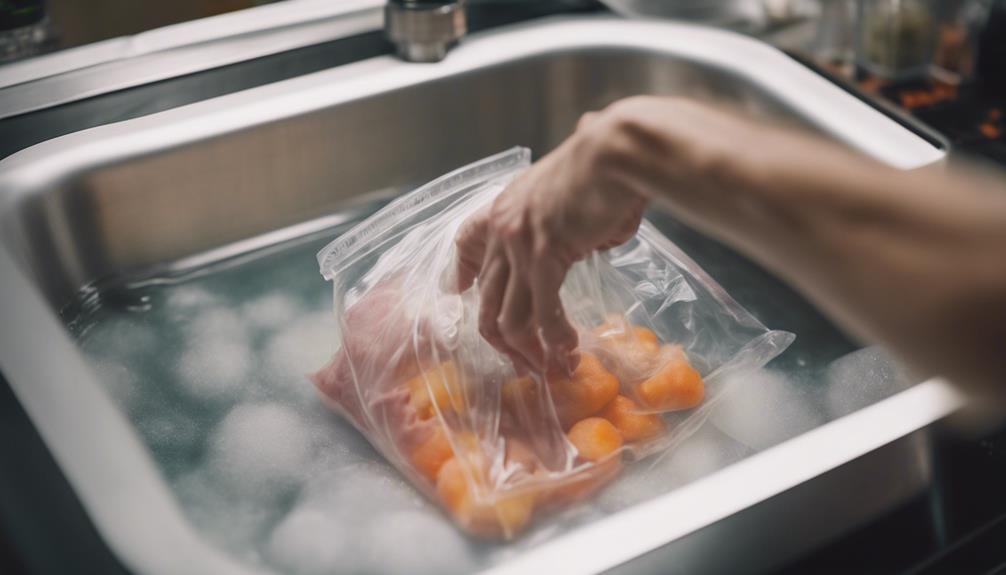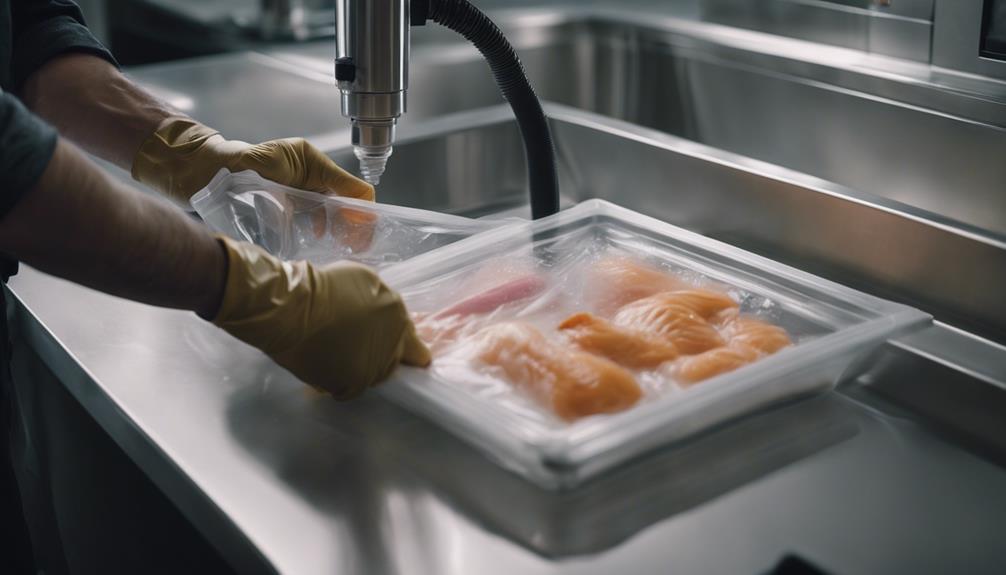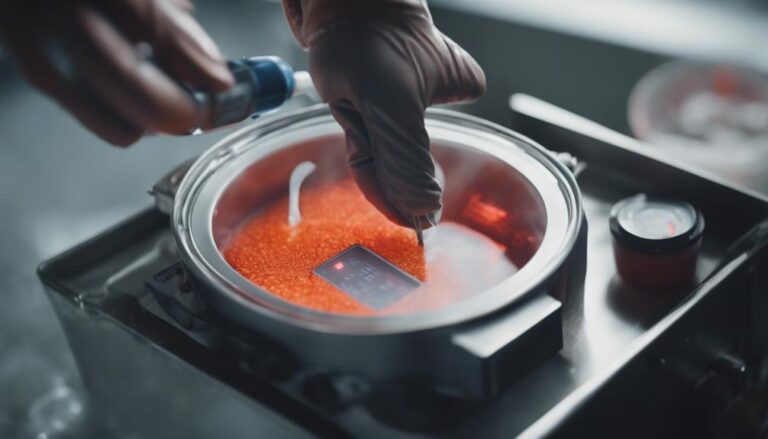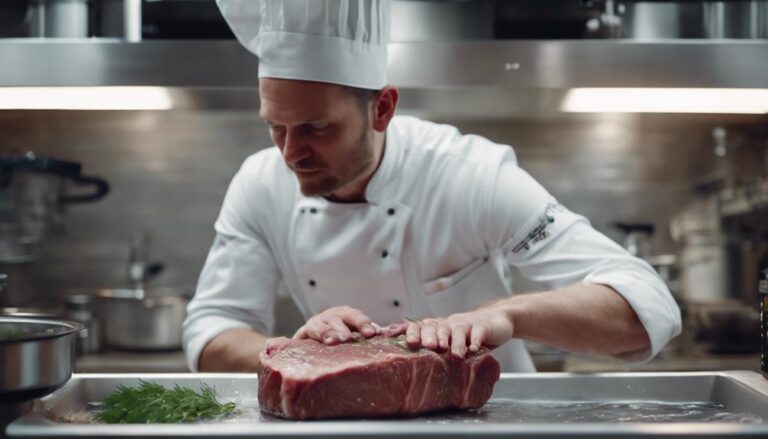Safe Handling Practices for Sous Vide Cooking
Guarantee safe sous vide cooking by maintaining proper temperatures above 130F to prevent bacterial growth. Verify temperatures with a dependable thermometer regularly. Safely pasteurize foods by cooking at specific temperatures for required durations. Use food-safe, BPA-free plastic and proper sealing techniques. Maintain hygiene by washing hands and sanitizing surfaces. Follow cooking guidelines diligently to discard food in danger zone. Prioritize food safety to enjoy delicious sous vide meals. Want more tips for safe handling and cooking?
What You Will Learn Here
- Maintain precise temperatures above 130F for pathogen control
- Use BPA-free, food-safe plastic for sous vide cooking
- Thaw ingredients thoroughly to prevent undercooking
- Follow recommended cooking times and temperatures meticulously
- Dispose of food in the danger zone to ensure safety
Importance of Proper Sous Vide Temperatures
Proper sous vide temperatures are essential for ensuring food safety and preventing bacterial risks during cooking. In sous vide, temperatures play an important role in eliminating harmful bacteria. Cooking below 130F (54.4C) is ineffective in killing bacteria, as they thrive between 40F (4.4C) and 126F (52.2C). To maintain safety, it's important to verify the circulator temperature regularly with a second thermometer. Extended cooks should always be at least 130F (54.4C) to prevent bacterial risks effectively.
When handling foods like chicken, blade-tenderized steaks, and low-quality fish in sous vide cooking, understanding pasteurization guidelines is key to ensuring safety. By adhering to recommended temperatures and cooking times, you can safeguard against potential health hazards associated with undercooked foods. Remember, proper handling and adherence to temperature guidelines are your best tools in creating delicious and safe sous vide dishes for yourself and others.
Avoiding Pathogen Growth in Sous Vide Cooking
To avoid pathogen growth in your sous vide cooking, it's essential to maintain safe temperature control and follow food safety guidelines diligently.
Preventing pathogens from multiplying requires cooking food at or above 130F for sufficient durations, especially when preparing meats.
Understanding these key points is vital in ensuring the safety of your sous vide dishes.
Pathogen Growth Prevention
How can you effectively prevent pathogen growth in sous vide cooking to guarantee food safety?
In sous vide cooking, pathogen growth thrives in the 'danger zone' between 40F (4.4C) and 130F (54.4C). To avoid this, make sure your food remains above 130F (54.4C) for extended cooking times.
It's essential to monitor and maintain accurate temperatures to halt pathogen multiplication. Following pasteurization guidelines for meats like chicken eliminates harmful bacteria, ensuring safe consumption.
Properly sealing and vacuuming food pouches before cooking helps prevent pathogen contamination and growth. By implementing these practices diligently, you can safeguard against harmful pathogens and enjoy safe sous vide meals.
Safe Temperature Control
When guaranteeing safe temperature control in sous vide cooking to prevent pathogen growth, maintaining a consistent temperature above 130F (54.4C) throughout the cooking process is essential.
Bacteria thrive between 40F (4.4C) and 126F (52.2C) in sous vide cooking, highlighting the significance of staying above 130F (54.4C) to prevent bacterial growth.
To assure food safety, verify the circulator temperature regularly using a second thermometer for precise cooking temperatures. It's advisable to cook a degree or two above the danger zone, especially for extended cooks.
Food Safety Guidelines
Maintaining a consistent temperature above 130F (54.4C) is crucial to guarantee food safety and prevent pathogen growth in sous vide cooking. To guarantee the safety of your sous vide-prepared meals, follow these guidelines:
- Ensure Proper Cooking Temperatures: All food must reach and sustain the minimum recommended temperature to inhibit pathogen growth.
- Use Reliable Resources: Rely on trustworthy recipes and accurate thermometers to confirm consistent temperatures, especially in the thickest part of the food.
- Quality Ingredients are Key: Opt for fresh, high-quality ingredients when engaging in low-temperature sous vide cooking to mitigate bacterial risks.
Ensuring Adequate Pasteurization of Foods
To guarantee safe consumption of sous vide cooked foods, proper pasteurization is essential to eliminate harmful bacteria effectively. Pasteurization involves cooking food at specific temperatures for a sufficient duration.
For instance, chicken should be cooked at 140F (60C) and held for 30 minutes to ensure pasteurization. This process is vital for maintaining food safety, especially for vulnerable groups.
Sous vide cooking offers precise control over pasteurization, allowing you to cook foods like medium rare steaks, ground beef, lamb, and duck breasts to perfection while ensuring they're safe to eat.
Understanding pasteurization temperatures and times is key to safe handling and serving of sous vide cooked foods. By following these guidelines closely, you can confidently prepare delicious sous vide meals that aren't only flavorful but also safe for everyone to enjoy.
Plastic Safety in Sous Vide Cooking

For safe sous vide cooking, it's important to understand the implications of using plastic in your cooking process. When it comes to Plastic Safety in Sous Vide Cooking, here are some key points to keep in mind:
- Cooking in food-safe, BPA-free plastic at low temperatures is generally considered safe for sous vide cooking.
- Many scientists and chefs believe that using plastic in sous vide cooking isn't risky, but different perspectives exist on the safety of cooking in plastic bags for sous vide.
- Research further on plastic safety in sous vide to make an informed decision about your cooking practices. Understanding the safety of plastic in sous vide cooking is essential for ensuring a safe culinary experience.
Make sure to follow proper handling practices to enhance your cooking process and prioritize the health and well-being of those you serve.
Guidelines for Cooking Rare Steaks Safely
When cooking rare steaks sous vide, it's essential to make sure that the internal temperature exceeds 130F (54.4C) to eliminate harmful bacteria effectively.
Maintaining the proper cooking temperature for an adequate duration minimizes the food safety risks associated with rare steak consumption.
Experts emphasize the importance of following pasteurization guidelines to guarantee safe consumption, especially for those with increased susceptibility.
Steak Doneness Levels
Achieving safe consumption of rare steaks through sous vide cooking involves precise temperature control and careful monitoring of pasteurization times. When aiming for a rare doneness level, it's important to follow recommended guidelines to guarantee safety.
- Core Temperature: Maintain a minimum of 130F (54.4C) to effectively kill bacteria in rare steaks.
- Pasteurization: Hold the steak at 130F (54.4C) or above for the recommended time to achieve pasteurization.
- Monitoring: Regularly check the core temperature of the steak to eliminate any bacterial risks and ensure safe consumption.
Cooking Temperature Safety
Maintaining a minimum temperature of 130F (54.4C) is vital for safely cooking rare steaks sous vide. Bacteria can thrive between 40F (4.4C) and 126F (52.2C), making it essential to confirm the steak reaches the recommended temperature to effectively kill any harmful bacteria.
When cooking rare steaks sous vide, verify the circulator temperature using a reliable thermometer to guarantee accuracy. It's important to follow the recommended time limits in the danger zone (40F to 130F) to minimize the risk of bacterial growth.
Best Practices for Safe Sous Vide Meals

To guarantee safe and delicious sous vide meals, always use vacuum-sealed bags designed for this cooking method. When preparing sous vide dishes, follow these best practices:
- Thaw frozen food completely before cooking to prevent bacterial growth and make sure even cooking.
- Follow recommended cooking times and temperatures for different types of food to guarantee safe and delicious results.
- Discard any food that has been in the sous vide danger zone for more than 2 hours to avoid health risks.
Ensuring Food Safety in Sous Vide Cooking
For ideal food safety in sous vide cooking, always guarantee thorough thawing of frozen ingredients before proceeding with the cooking process. Thawing frozen food completely is essential to make sure of even heat distribution during cooking, reducing the risk of bacterial contamination.
When using sous vide, it's vital to utilize vacuum-sealed bags specifically designed for this cooking method to prevent any potential contamination. Follow recommended cooking times and temperatures meticulously to maintain food safety standards. Discard any food that has stayed in the danger zone (40F to 130F) for over 2 hours to mitigate bacterial risks effectively.
Maintain strict hygiene standards by washing your hands thoroughly before handling food and ensuring all surfaces and utensils are sanitized. By adhering to these practices, you can prevent contamination, uphold food safety, and guarantee delightful sous vide meals for yourself and those you serve.
Frequently Asked Questions
What Is the Safety of Sous Vide Cooking?
To guarantee safety in sous vide cooking, you must prioritize temperature control, pasteurization processes, and food safety. Proper risk assessment, pathogen control, and heat distribution are essential. Remember to contemplate microbial growth, cold storage, and time limits for quality assurance.
What Are the FDA Guidelines for Sous Vide?
When cooking sous vide, maintain precise temperature control with appropriate equipment. Vacuum seal food for safe immersion in water. Follow FDA guidelines for pasteurization to eradicate bacteria. Uphold food safety by adhering to recommended time requirements.
What Are the Regulations for Sous Vide Cooking?
When cooking sous vide, regulations focus on maintaining precise temperature control, ensuring food safety, and pasteurizing for specific times. Following guidelines prevents bacterial growth, guarantees safe meals, and demonstrates a commitment to high standards of food safety.
What Principles Are Applied in Sous Vide Cooking to Make It a Safe Cooking Method?
To make sous vide cooking safe, guarantee precise temperature control, proper vacuum sealing, and thorough pasteurization. Monitor food temps, follow cooking times, and prevent bacterial growth. These practices reduce the risk of foodborne illnesses.
Conclusion
In summary, following safe handling practices is essential for sous vide cooking to prevent foodborne illnesses.
By maintaining proper temperatures, pasteurizing foods adequately, using safe plastic materials, and following guidelines for rare steaks, you can guarantee that your sous vide meals are safe to consume.
Remember to always prioritize food safety in your cooking practices to enjoy delicious and worry-free meals.









